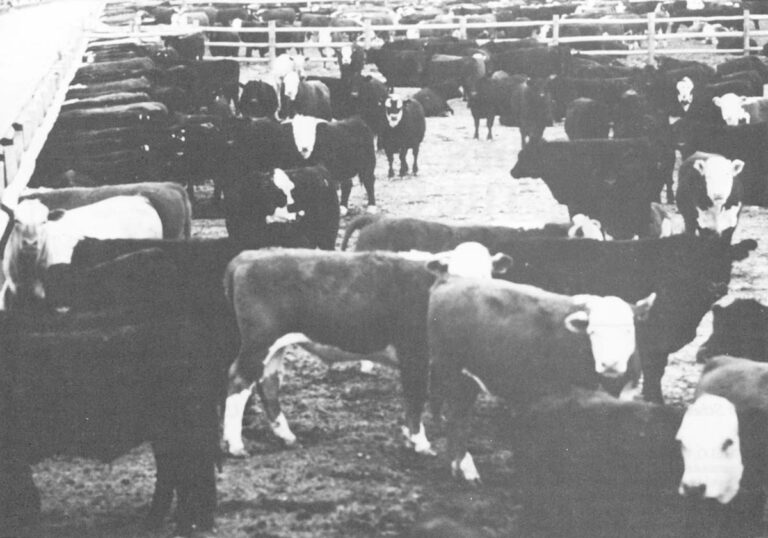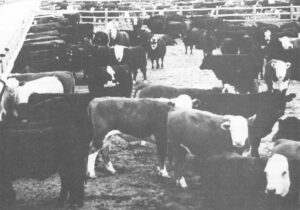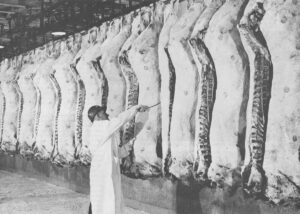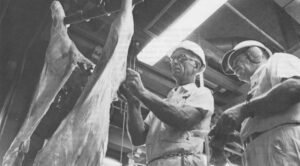(AMARILLO, TX) — During any other year, those in attendance at the Texas Beef Conference would have gathered for a few seminars on grain processing and manure disposal, taken a break for cocktails before sitting down to a barbecue sponsored by the “T-Bone Club”, and that would have been that.
But this year when the Conference opened in the Amarillo, Texas Hilton Inn, things were a little different. Several weeks earlier the Food and Drug Administration had learned that two Texas Panhandle feedlots, with a capacity of over 70,000 head of cattle, were illegally implanting the ears of their animals with the synthetic estrogen diethylstilbestrol, or DES. After undergoing a long legal battle, the FDA had finally banned DES, a potent carcinogen, in July of 1979.
FDA officials were angered by the flagrancy of the violations. But perhaps the whole brouhaha would have died down if it had ended with the two lots. However, by the time the Texas Beef Conference convened, the number of feedlots found to be still using DES implants had risen to one hundred and fifty six. Almost 400,000 head of cattle in eighteen states were found to be involved.
The number of lots and implanted cattle grew almost daily with new disclosures. When FDA inspectors went to examine the invoices of drug purchases at the violative lots, it further discovered that some 25 drug distributors had also continued to illegally market DES after the July 13, 1979 cutoff date.

Incensed by the apparent willfulness of the violations, Secretary of Health Education and Welfare, Patricia Harris issued a statement which called for criminal prosecutions, fines and even jail sentences for the offenders. She accused the cattlemen of being “calculated and intentional” in their decision to disobey the law and continue using DES. She berated them for letting economics “outweigh any ethical considerations.”
Such a statement may have endeared the Secretary to consumers, but did nothing but enrage the cattlemen. While they were more than a little evasive in responding to questions about who had made the final decision to continue implanting with DES at their respective operations, they were not the slightest bit vague about their contempt for the government regulatory agencies and the officials who were now condemning them. In their minds, it was not the feedlots which were responsible for the predicament in which the beef industry now found itself, but the government which had outlawed DES in the first place. In their minds, the law seemed an irrelevant detail.
Indeed, there was an irony in the FDA’s attempts to decide to prosecute the cattlemen. There was no question that they had cynically broken the law. But it seemed arbitrary to the cattlemen that the FDA, which had allowed DES to be used for over 20 years not only as ear implants, but as a feed additive as well, was now being so righteous.
“People have been eating meat raised on DES for years,” exclaimed one irritated feedlot manager from Deaf Smith, Texas standing next to a glass case which contained a prize-winning prime rib roast from the High Plains Fed Beef Carcass Show, an annual Conference event. “Even the FDA says now that there is no immediate health hazard. But now we’ve got to remove all these goddamn implants and hold the cows for 30 to 60 days just because the FDA gets crazy. Well, if it’s such awful stuff, why didn’t they ban it back in the beginning?”
That is, in fact the million dollar question which cattlemen are asking. It appears somewhat of an anomaly to them that the FDA should be at once taking after the cattlemen for illegally implanting their stock with DES, while at the same time refusing to admit that meat raised on the same substance in the past was “unwholesome.”
The truth, however, is that no one quite knows how many of the drugs and chemicals now used in food production will finally effect those who ingest them. The confusion over DES has been long, and the debate over whether or not to ban it complicated. The FDA, after floundering around for almost a quarter of a century on the subject, has now decided to come down on the side of prudence. But prudence to the cattlemen is hardly convincing. They want to know, “Where are the people who have gotten sick and died from DES-raised meat?” “Where are the statistics?” Since there are only dead laboratory rats and mice to show, the cattlemen are unconvinced. They are also angry.
In the Syntex Agribusiness Inc. hospitality room just off the main lobby, a giant indoor garden, several cattlemen gather at the end of their afternoon seminars for complimentary drinks and pretzels. One might have thought that Syntex, makers of a rival growth promoting a hormonal implant called, Synovex (a progesterone/ testosterone agent whose motto is: “Synovex implants can make heavyweight champions out of lightweight contenders”) would be pleased to see DES, their main rival removed from the market. But far from it.
“I just don’t know how to put it in words,” says Carl Cooper, a young Syntex factory salesman in charge of Texas, Oklahoma, Kansas and Arizona shaking his head. “Syntex doesn’t make DES. But still we hate to see it go off the market. In fact, even though we are competitors, we’d love to see them approve it for use again. Next thing you know, they’ll be after our implants too.”
In fact, a year ago, even before finally banning DES, the FDA had already called for hearings on Synovex.
“I’ve been feeding cattle for 32 years,” says Carl Stevenson, the affable owner of Red Rock Feeding Co., Red Rock, Arizona, a lot with a capacity of 20,000 head. “And we’ve used DES for over twenty-five years of that time and I haven’t seen any problems. DES is just a wonderful drug for improving the efficiency of an animal. And it makes me real mad to see the government ban it.”
“What is it about DES that makes it work so well?” I ask Stevenson.
“I’m not quite sure I can tell you,” he demurs, his tanned face breaking into a somewhat sheepish smile.
“DES is a synthetic hormone,” says Cooper coming to the rescue.
Then he too seemed to lose explanatory momentum.
“Actually,” he continues after a pause, “when you get right down to the front line of it, I can’t exactly tell you how it works. It just does.”
Stevenson nods in wordless agreement.
“DES provides a 10-12 percent increase in weight gain and feed efficiency for cattle,” interjects Dr. Bill Hale, a vet and Professor of Animal Science at the University of Arizona, from across the room. “You get all that for about nine cents a head, the cost of one DES implant. And, I’ve never heard of any problem that anyone has been able to attribute to DES.”
There are others however, not here at the Texas Beef Conference who do not share Dr. Hale’s conviction that DES is without problems.
“There is no question about the carcinogenicity…of DES in animals,” says Dr. Umberto Saffloti, Associate Scientific Director for Carcinogenesis, National Cancer Institute. “This is well established. It is one of the chapters in a textbook on cancer research.”
“Sure. DES may be carcinogenic,” counters Dr. Hale, “But as far as I know they have never found any DES residues in muscle tissue of animals if the proper withdrawal times are observed. You may get a little in the organ meats, liver and kidneys, but there, we’re talking parts per billion,” he adds almost parenthetically.
“What did I hear about that?”, enjoins Stevenson. “Something about how you would have to eat 110 pounds of liver a day to get the same equivalent dose they feed to those lab rats. It’s just Delaney Amendment idiocy.” (The Delaney Amendment to the Food Drug and Cosmetic Law proscribes that, “No food additives shall be deemed safe if it is found to induce cancer when ingested by man or animal…”)
“No level of exposure to a chemical carcinogen should be considered toxicologically insignificant for man…” says a U.S. Surgeon General’s report entitled “Evaluation of Environmental Carcinogens.” “A safe level for man cannot be established from our present knowledge.”
It does seem almost absurd to be talking about something as small as parts per billion of DES in a state where everything is on such a grand scale as it is here in Texas. Indeed, from out here on the high plains of the Panhandle where people are engaged in volume production of meat; where large feedlots stretch out over the flat landscape for hundreds of acres; and where the vastness of the prairie desert surrounds the human and animal enclaves like an ocean, a DES implant (which can just be seen with the naked eye) seems trivial. All the cautionary evaluations, and government officials trying to regulate the tidal wave of unseen drugs and chemicals which go into meat production, somehow seem too abstract and remote when one is standing in the middle of a feedlot surrounded on all sides by cows which look harmless and normal.
“Can you believe that this little fella is what this big deal is all about?” said a cowboy later on in one feedlot as he removes a DES implant from the ear of a steer and flicks the tiny white grain into the manure with his thumb and forefinger.
Slowly the Syntex Agribusiness Inc., hospitality room at the Amarillo Hilton is filling up with cattlemen in cowboy boots, western shirts and western styled leisure suits. There is a conviviality among this fraternity of cattlemen, many of whom know each other, and share a common political concensus.
“Shit!” says Carl Cooper, putting out a fresh supply of half gallon liquor bottles, several quarts of soft drinks and a bucket of ice on a makeshift bar. “Folks down here are real steamed up over this one. Just a moment ago, right outside the door, this cattleman almost took a punch at this other guy. I think he must have been with the government or something.”
The others in the room laugh knowingly.
“You could talk to any feeder here at the Texas Cattle Feeders Association,” continued Stevenson. “They’d put an implant in a steer today and eat it tomorrow. Most of your consumers are just afraid of DES because that’s what they hear from the press. But this whole thing is not a black and white deal. It’s not just the cattle feeders trying to get rich and sticking it to the public. Our American cattle are the cleanest, finest and most disease-free product in the world. And our industry is one of the most efficient. Just look at the relatively low cost of food in this country!”
“I think this whole organic food business is the dumbest thing I ever heard of,” he adds changing his focus. “Most of that food is just bought at the super market like anything else. Then, they punch a few worm holes in it, call it organic, and sell it at a higher price. Those organic stores are unscrupulous. They’re just merchandising off the ignorance and fear of consumers.”
“If the FDA believed DES was so goddamned dangerous that they had to ban it, how come they never recalled it?” asks Stevenson, pausing a minute as if he expected an answer. “I mean, where did they think it would all go? If they were so afraid of it, why didn’t they take the time to put the clamp on its distribution?
“I quit using DES not because I think it’s bad,” says Stevenson accepting another free drink from Cooper, “but simply because I didn’t want to deal with the consequences.
“My son, who manages our lot, said that he wanted to go on and use it after the ban. I said to him, ‘Dan. I don’t want the goddamn government on our backs. I just don’t want the hassle.’”
“I wasn’t against DES. In fact we bought 20,000 doses just before the sale cut-off date in July and used them right until the ban on further implantation went into effect in November. We followed the letter of the law. We’d had enough environmental crap already and didn’t want to have to fight on this one too, because you just can’t win. But I think it is a damn shame the government is messing around in everything so we can’t legally use it now.
“Everything is so regulated. I mean, a lot of these cattlemen just have the attitude, ‘If the government’s gonna screw us, we’ll just give ‘em a good screwing right back.'”
Although most of the other cattlemen have by now left the Syntex Hospitality room to join a cocktail Social Hour in the lobby, Carl Stevenson is still going strong.
“I think we have a vindictive government,” he says. “I feel that the government tries to hurt us when it can. Cattlemen are a very conservative group. We don’t believe in their liberal philosophy, and that puts us on the government’s shit list. I really believe that they take great pleasure in hurting us.”
“What people don’t realize,” says Carl Cooper shaking his head in resignation behind the bar, “is that the cattle industry is depressed right now. Fuel costs are up. It’s impossible to get loans. There are a bunch of feedlots operating at 55 percent capacity. All these factors, and now this DES thing, are going to combine and put some of them under.”
“We can’t stand any more bad news in the industry,” laments Stevenson. “We’re losing $60-90 a head right now. I personally own 6,000 head of cattle in our lot. I could lose half a million dollars on them. People more knowledgeable than I tell me that a third of the nation’s feed lots could go out of business this year.”
He shakes his head, seemingly depressed by his own prognosis.
“If there were no goddamn government regulations, everything would probably be just the same,” he says, brightening a little, then stops a minute to consider what he has just said.
“No. Well, let me put it this way. Probably 75 percent of them are useless. Did you know that there were 77,000 pages of new regulations in the Federal Register last year alone? That’s several bibles worth right there. And the sorry thing about it is, there is no other country in the world today which approaches the U.S. in the vigor of its agriculture. It’s a strength that most people in America take for granted. I’d hate to see the government strangle it.”
©1980 Orville Schell
Orville Schell is investigating the “Reliance on Drugs and Chemicals in the U.S. Meat Industry.”






